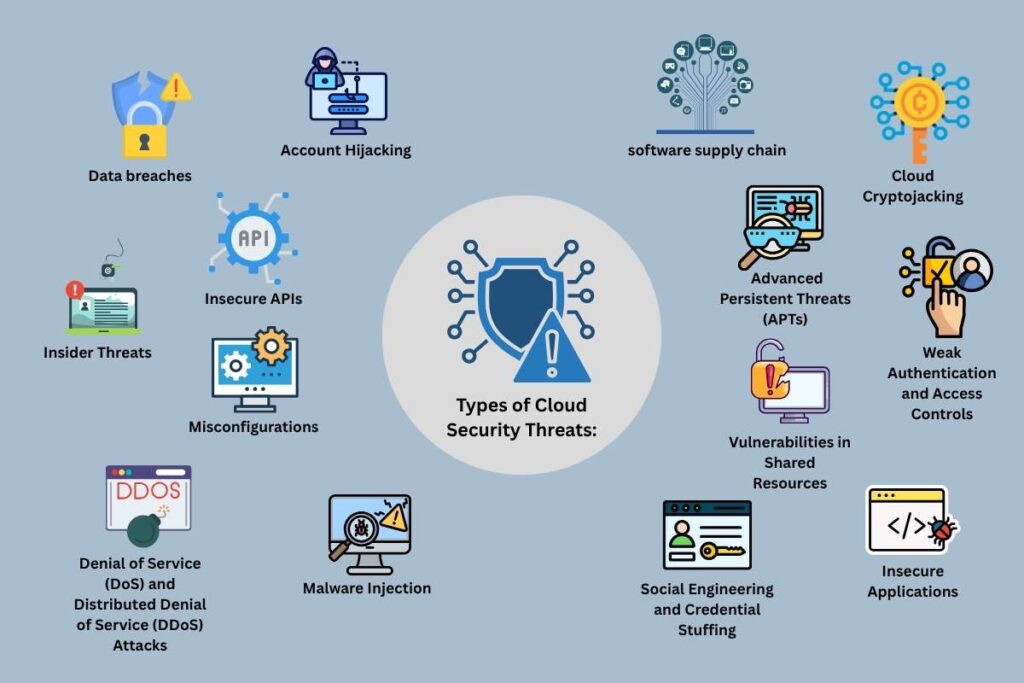Are Your Files Really Safe? The Hidden Cloud Security Threats You Shouldn’t Ignore
Cloud security threats are real, growing dangers that target data, applications, and infrastructure in cloud environments. From data breaches and misconfigurations to insider attacks and account hijacking, these threats expose critical vulnerabilities that demand proactive defense strategies.

A shadow looms in the digital space, a threat that can destroy your most personal information. Is the convenience we depend upon each day, a pathway unseen to dangers? The reality is that we live in relative ignorance that our data is, in some way, safe in the digital world that we now share. But this lack of understanding is exactly what leaves us vulnerable, a huge hole in our defenses that attackers are eager to exploit.
Think about this: the most private details, your company’s secrets, placed simply for anyone to see, not through a direct hack, but because of a subtle error. This disturbing reality branches from the complex world of cloud security threats. These aren’t just abstract risks; they are real, growing dangers that, if left unaddressed due to our combined unawareness, can lead to shocking data compromises.
What are Cloud Security Threats?
Cloud security threats represent a sizable variety of possible threats to data, applications, and infrastructure that are hosted in cloud environments. Backblaze reports over 700 breaches or malicious activities since 2020. These threats are sometimes the result of a shared responsibility model that already expects both a cloud service provider and their user to have a role in security, meaning if either party fails, a breach is possible.
The common threats are usually data breaches where unauthorized parties have accessed sensitive information; misconfigured cloud settings that leave systems exposed to the public; insecure application programming interfaces (APIs) that attackers use to access; account hijacking where login credentials have been stolen; insider threats from employees or partners; and denial-of-service (DoS) attacks that disrupt service availability. Threats to cloud security pose a significant challenge to organizations to achieve a secure and resilient cloud environment as they increasingly turn to cloud platforms.
The complexity and dynamic nature of cloud environments, paired with the inability to gain visibility or manage, are obvious risk factors and need to be considered seriously before using cloud security.
Types of Cloud Security Threats:

1. Data breaches:
Data Breaches are set in motion when unauthorized access to sensitive data that is in cloud storage occurs, which is often due to misconfiguration, weak authentication protocols, or insider threats. A data breach can have consequences such as legal, financial, and reputational damage to an organization.
Example: It would be the 2018 Facebook data breach, where Cambridge Analytica had accessed user data without their consent through an insecure API.
Also Read :- Safeguarding Your Business: Understanding, Preventing, and Responding to Data Breaches
2. Account Hijacking
Account hijacking happens when attackers gain unauthorized access to cloud accounts through phishing and credential stuffing to manipulate data, steal information, or continue their attacks.
Example: The 2019 copyright data breach, where a hacker accessed over 100 million customer accounts through a compromised, misconfigured application firewall.
Also Read :- How Websites Get Hacked through Cross-site Scripting (XSS) ?
3. Insecure APIs:
Threat actors can exploit vulnerabilities in Application Programming Interfaces APIs to bypass security controls and ultimately gain access to cloud environments directly. APIs can be exploited for a variety of attacks, including injection attacks, MITM attacks, DDoS attacks, and Server-Side Request Forgery (SSRF).
Example: The T-Mobile data breach in 2024, which affected 37 million customer accounts and occurred through a single API without proper authorization.
Also Read :- Why Mobile App Penetration Testing Matters?
4. Insider Threats:
Insider data loss refers to an insider (the authorized users of an organization) – e.g., employee, contractor, or authorized partner – misusing their access rights either intentionally or accidentally to create data loss, system disruption, or other malicious events. Insider-compromised data loss can be difficult and sometimes impossible to identify or diminish, given the fact that insiders have authorized access.
Example: The Tesla data leak from May 2023 involved 2 former employees leaking sensitive information, exposing the data of over 75,000 individuals.
Also Read :- Insider Threats in Cyber Security-Prevention is Better than Cure
5. Denial of Service (DoS) and Distributed Denial of Service (DDoS) Attacks:

Example: In 2020, an AWS DDoS attack with traffic peaks of 2.3 Terabits per second impacted many of its customers.
Also Read :- Denial of Service (DoS) Attack: What It Is and How to Protect Against It?
6. Misconfigurations:
Mistakes in setting up or managing cloud services, for example, access controls, firewall rules, or public storage buckets, can expose private information to unauthorized parties. This is one of the most frequent causes of cloud security failures.
Example: Verizon 2017 data exposure incident due to the incorrect configuration of public buckets in its AWS S3 storage, resulting in millions of customer records’ exposure.
7. Malware Injection:
As demonstrated in the 2020 SolarWinds attack, attackers can inject malicious code into cloud workloads to obtain data, disrupt services, and compromise defenses for later use.
Example: Codecov Bash Uploader Attack in 2021. Attackers injected malicious code into Codecov’s Bash Uploader script, giving them access to secrets from CI/CD pipelines used in cloud apps.
8. Supply Chain Attacks:
These types of attacks are made possible by taking advantage of vulnerabilities in the software supply chain to compromise cloud services or to target numerous organizations at once. For example, the 2024 XZ Utils attack.
Example: SolarWinds MSP Hack (N-able, 2021). Beyond Orion, attackers targeted SolarWind’s MSP tools used by cloud service providers, spreading access across multiple enterprises.
9. Cloud Cryptojacking:
Attackers are taking control of cloud computing resources without authorization to mine copyright.
Example: The 2020 Jenkins Servers incident, Hackers compromised unsecured Jenkins automation servers in the cloud to run mining scripts for Monero copyright.
10. Advanced Persistent Threats (APTs):

Example: Nobelium Attack on Azure Cloud in 2021. The group behind SolarWinds pivoted to infiltrating Microsoft Azure environments, using stolen tokens to maintain long-term access.
11. Weak Authentication and Access Controls:
Weak passwords, no multi-factor authentication, or insufficient Identity and Access Management (IAM) policies create attack vectors.
Example: U.S. Colonial Pipeline of 2021. A compromised VPN account with no MFA allowed DarkSide hackers to access internal systems, causing massive cloud-based service disruption.
12. Vulnerabilities in Shared Resources:
Attackers target vulnerabilities associated with shared infrastructure in multi-tenant cloud environments where they exploit weaknesses to gain access to other organizations’ data.
Example: Venom Vulnerability during 2015. A flaw in QEMU’s virtual floppy drive let attackers escape from virtual machines and potentially access other tenants in shared cloud platforms.
14. Social Engineering and Credential Stuffing:
General techniques, such as phishing (or stealing credentials), are used to gain access to systems.
Example: Dropbox Employee Phishing in 2022. Phishing emails tricked employees into giving up credentials, granting access to GitHub repos containing cloud API keys.
15. Insecure Applications:
Attackers leverage vulnerabilities in cloud-based applications resulting from bad coding or missing security updates.
Example: Facebook AWS Leak (2019). Third-party cloud apps used by Facebook partners exposed hundreds of millions of records due to poor coding and unsecured S3 buckets.
Source for the types:
Case study: Hijacked in the Cloud: Lessons from an Amazon Web Services Attack
The case study on Amazon Cloud Services highlights the growing reliance on cloud infrastructure and the accompanying cloud security threats that can undermine its benefits. Key vulnerabilities include data breaches, weak API security, insider threats, and account hijacking. A notable example cited is a 2010 incident where attackers used a cross-site scripting (XSS) exploit to infiltrate Amazon’s Relational Database Service (RDS), leveraging it to deploy the Zeus Trojan for large-scale credential theft. The study underscores how even a single compromised entry point in the cloud ecosystem can be exploited to launch broader attacks. It also stresses the importance of strong encryption, API key management, multi-factor authentication, and vigilant monitoring to defend against persistent threats in cloud environments.
Source: https://www.researchgate.net/publication/276499055_Cloud_Security_Services_Risks_and_a_Case_Study_on_Amazon_Cloud_Services
Conclusion:
As businesses and individuals rapidly adopt cloud technology, they are faced with its dark side, too. The cloud security threats no longer exist in the world of threat modeling; they are real, growing threats that can disrupt operations, expose sensitive data, and ultimately diminish trust. From misconfigured services to insider breach points, the threats now exist and grow every day.
Practical examples and the Amazon case study make it evident that ignoring the cloud security threats is no longer an option. Organizations need to begin thinking about security in a proactive manner, using stronger access controls, and begin practicing a security-oriented organizational culture when using any type of cloud technology. Because in the digital age we live in, it is not a feature, it’s a must.
FAQ:
1. What are the four types of cloud security?
From IaaS to SaaS, cloud security types include Network Security, Identity and Access Management, Data Encryption, and Compliance Monitoring, to ensure your cloud assets are protected from cyber threats and compliance risks.
2. What are the five pillars of cloud security?
The Five Pillars of Cloud Security, Identity and Access Management, Data Encryption, Network Security, Compliance and Governance, and Security Incident Response and Recovery provide a comprehensive framework to protect your cloud resources effectively.
3. What is the number one issue for security in the cloud?
Data breaches: This common cloud security risk occurs when sensitive information is extracted from an organization without its permission or awareness. Misconfigurations and the lack of runtime protection can leave data vulnerable to theft, resulting in financial loss, reputational damage, and legal liabilities.